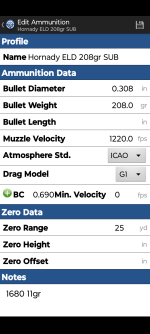I have posted this on a local Forum too, hopefully someone can chime in...
First and foremost, I am far from being an expert, and my gear is just entry level, so please bear with me if I am missing something obvious.
I have recently purchased an Athlon chronograph to measure more reliably the velocities on my rifles.
However, with my 22LR and 300 BLK bolt rifles, once I plug the velocity in my Shooter App, reality does not match the provided ballistic solution.
In order to reconcile the two I must enter a velocity higher than what my chrono says.
Once I do that, everything falls into place.
My understanding is that this seems to be a pretty common issue with rimfire ballistics Apps and just a few Apps will be able to calculate the real trajectory of a given rimfire load.
The consensus seems to be to tweak things until expectations match reality.
The Shooters App even has a "Velocity Calibration" option to do just that.
I have now confirmed that the same seems to happen with my 300 BLK bolt rifle.
Both subsonic and supersonic loads are plagued by this issue, with the supersonic loads requiring a tweaked velocity close to 300fps higher than the chronographed value.
Again, once the "correct" velocity was entered, I was able to consistently ring a 12" gong all the way to 330yds (probably could have gone further than that but I did not have the chance today).
I get the same results both indoors up to 100 yds and outdoors,so air pressure and temperature discrepancies are not a factor.
I am pretty confident in the chronograph readings since my 308 and 338LM are spot on.
This only seems to happen with 22lr and 300BLK, both calibers in sub and supersonic loads.
Sure, I have figured out the "right" velocity to plug into my app and I can now make my hits, but what is causing this?
Is it just a "glitch" with the App or is there some factor I am not considering?
The parameters I enter on any given load are:
Bullet Diameter
Bullet weight
Muzzle velocity
Atmosphere:ASM
Drag Model:G1
BC
Zero range
Am I missing something?
Shooter App acquires atmospheric data based on your GPS from the nearest weather station.
Obviously, if I am indoors, air pressure and temperature will be different from the data provided by the app (the app will give data for outdoors, at that location).
And yet, the indoors tweaked velocity worked quite well outdoors this morning with minor adjustments on the 300BLK Sub (1220 fps vs 1240 fps indoors).
The Supersonic loads required no further adjustment to the velocity.
I mean, it works.
But I wish I could understand the "mechanics" of it.
I used to think I lived in a Universe where 2+2=4...I guess that's not entirely true.
Can anyone PLEASE explain me how that is even possible?
First and foremost, I am far from being an expert, and my gear is just entry level, so please bear with me if I am missing something obvious.
I have recently purchased an Athlon chronograph to measure more reliably the velocities on my rifles.
However, with my 22LR and 300 BLK bolt rifles, once I plug the velocity in my Shooter App, reality does not match the provided ballistic solution.
In order to reconcile the two I must enter a velocity higher than what my chrono says.
Once I do that, everything falls into place.
My understanding is that this seems to be a pretty common issue with rimfire ballistics Apps and just a few Apps will be able to calculate the real trajectory of a given rimfire load.
The consensus seems to be to tweak things until expectations match reality.
The Shooters App even has a "Velocity Calibration" option to do just that.
I have now confirmed that the same seems to happen with my 300 BLK bolt rifle.
Both subsonic and supersonic loads are plagued by this issue, with the supersonic loads requiring a tweaked velocity close to 300fps higher than the chronographed value.
Again, once the "correct" velocity was entered, I was able to consistently ring a 12" gong all the way to 330yds (probably could have gone further than that but I did not have the chance today).
I get the same results both indoors up to 100 yds and outdoors,so air pressure and temperature discrepancies are not a factor.
I am pretty confident in the chronograph readings since my 308 and 338LM are spot on.
This only seems to happen with 22lr and 300BLK, both calibers in sub and supersonic loads.
Sure, I have figured out the "right" velocity to plug into my app and I can now make my hits, but what is causing this?
Is it just a "glitch" with the App or is there some factor I am not considering?
The parameters I enter on any given load are:
Bullet Diameter
Bullet weight
Muzzle velocity
Atmosphere:ASM
Drag Model:G1
BC
Zero range
Am I missing something?
Shooter App acquires atmospheric data based on your GPS from the nearest weather station.
Obviously, if I am indoors, air pressure and temperature will be different from the data provided by the app (the app will give data for outdoors, at that location).
And yet, the indoors tweaked velocity worked quite well outdoors this morning with minor adjustments on the 300BLK Sub (1220 fps vs 1240 fps indoors).
The Supersonic loads required no further adjustment to the velocity.
I mean, it works.
But I wish I could understand the "mechanics" of it.
I used to think I lived in a Universe where 2+2=4...I guess that's not entirely true.
Can anyone PLEASE explain me how that is even possible?



